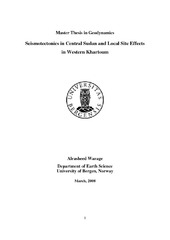| dc.description.abstract | The central part of Sudan is tectonically significant and thus needs to be studied. In recent years, the central part has grown economically and the population has increased. This results in growing interest to estimate the seismic hazard through tectonic and seismological studies. In the present work we have carried out two studies. We have used earthquake data to analyze the seismotectonics of the area and conducted a local site effects study in the western part of Khartoum. The first part discusses the seismicity and tectonics of central Sudan. Five significant earthquakes are used to constraint mechanism of the seismic sources in the area. Earthquakes are relocated and the focal mechanism of the 1966 earthquake is made. We observed that all the events are associated with normal and strike-slip faulting. Focal mechanism of the 1966 earthquake in the southern part of central Sudan is interpreted as a left lateral strike-slip fault. It has similar focal mechanism as the 1993 earthquake in the northern part of central Sudan. Both of them are conformable with the same stress regimes in that area. However, they do not fit with the orientation of the stress tensor dominated by the Red Sea and East African Rift Systems. In the second part of this work, we have surveyed the site effects in western part of Khartoum city (Omdurman and western Khartoum town). The H/V spectral ratio method is used to calculate the fundamental site frequencies and amplification factors in different sites. The geological conditions of these sites are different, which contain basement rocks, mainly granite, exposed at the boundaries of the area and covered by Cretaceous and Quaternary sediments in the central part. In the study area, we observed that the agreement of the fundamental site frequencies and the amplification factors with the underlying geology was good. The method itself is known to be less reliable for the estimation of the exact amplification factor. Therefore the standard spectral ratio method was tried with earthquake data to estimate the amplification factors in the Khartoum area. However, the earthquake locations did not satisfy the far-field criteria and hence the results were not useful. In spite of this, we observed that the H/V ratio and the standard spectral method gave reasonably good correlation for the fundamental sites frequencies. Both methods show good agreement between the sites response and the underlying geology. Furthermore, the H/V spectral ratio results are similar to the analytical studies conducted by Mohamedzein et al (2006) in central Khartoum. We believe that the present work highlights the importance of local site effects in Khartoum and needs to be taken into account in estimating the earthquake hazard in the area. | en_US |
